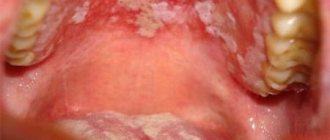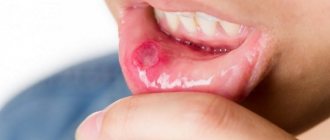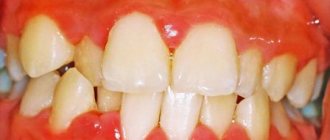What is stomatitis
Stomatitis (mucositis) is a disease that is accompanied by damage to soft tissues in the oral cavity.
It can be either an independent disease or a complication of various pathological processes, for example, measles, influenza, scarlet fever, etc. Until recently, stomatitis was considered a childhood disease. Today it is becoming more common in adults too. This trend raises questions about whether stomatitis is transmitted and, if so, how to protect yourself and your child. It all depends on the form of manifestation of the disease
Prevention of stomatitis
All measures aimed at preventing stomatitis in adults and children coincide with preventive measures against the occurrence of caries and other dental problems. The main recommendations are a healthy lifestyle, adequate oral hygiene and timely visits to the dentist.
We remind you that for preventive purposes you need to visit the dentist’s office once every 6 months - even if nothing bothers you.
We invite you to Genesis for a preventive examination! ←Return to list of articles
Symptoms of stomatitis
Stomatitis can be recognized by the following signs:
- ulcers, wounds, erosions and rashes on tissues;
- red color of the mucous membrane;
- plaque on the tongue, inner surface of the cheeks, palate;
- unpleasant taste;
- swelling of tissues;
- heavy salivation;
- bad breath;
- itching and burning – in some cases;
- discomfort and pain;
- bleeding gums – occasionally;
- increased body temperature;
- lymphadenitis.
Symptoms in children are always more pronounced. The child often feels severe pain. Adults tolerate the disease easily. Its symptoms usually do not cause severe discomfort.
When the first symptoms appear, you should immediately consult a doctor to protect yourself and, possibly, others.
Causes
Viral stomatitis in childhood develops due to various infections, since the baby has an underdeveloped immune system. He does not have time to recover from his previous illness. It also easily becomes infected from a patient with stomatitis. The situation is worsened by a lack of nutrients and vitamins in the body.
The disease in children is caused by the following pathogens:
- flu;
- HIV;
- mononucleosis;
- measles;
- papillomavirus;
- ARVI;
- enterovirus;
- chicken pox;
- herpes.
Most often, herpes is the causative agent of this disease; it accounts for up to 80% of all cases. Most of these viruses are persistent intracellular parasites. Therefore, this disease often becomes chronic. With this form, there is an alternation of exacerbations and remissions. The acute form can result in the formation of a carrier state, in which the pathogen remains in the cells, but there are no symptoms of the disease.
Most often, the infection affects children under four years of age. But it affects older children and teenagers.
The reasons why this happens are:
- undeveloped immune system;
- insufficient oral hygiene;
- weakness of local immunity;
- injuries to the gums and oral mucosa;
- general weakening of the body after an illness;
- long-term use of certain drugs (glucocorticoids, antibiotics, cytostatics).
Parallel inflammatory processes in other organs and systems also contribute to maintaining the infectious process in the mouth of children.
Types of disease
Stomatitis has different forms, depending on which the doctor determines whether it is contagious or not, and also prescribes appropriate treatment.
Allergic stomatitis
This is a common form of the disease that is difficult to treat. From the name it is clear that the cause of its development is an allergy, but it is necessary to find out what exactly it is. These could be medications, food, materials used for prosthetics. The disease is accompanied by the appearance of ulcers, which provoke pain.
Viral stomatitis
The most common type of viral stomatitis is herpetic stomatitis, the causative agent of which is the herpes virus. There are other forms that are provoked by adenovirus, enterovirus, etc. They are often found in children under 5–6 years of age, but are also common among older age groups. A feature of viral stomatitis is its erosive spread, when one ulcer appears next to another. Herpes mucositis may cause complications such as fever, nausea, vomiting and diarrhea.
This form of the disease is transmitted to others by contact and airborne droplets. If it is diagnosed, for example, in someone in kindergarten, then quarantine must be introduced. Infection occurs through dishes and toys, so the disease can quickly spread from child to child.
The virus spreads from nursing mothers to children if hygiene rules are violated. Adults become infected even through handshakes. Sneezing also causes the disease to develop.
Aphthous stomatitis
This form is common among adults. It develops against the background of a weakening of the body’s immune forces, so aphthous stomatitis is a common occurrence in spring and autumn. With this type of disease, characteristic aphthae appear - small ulcers. They can be single or group. Aphthous mucositis is not spread from person to person.
Fungal stomatitis
The disease manifests itself in children and adults, mainly in infants and women. It is provoked by fungi of the genus Candida, which are activated in the oral cavity when the immune system is weakened. The cause of fungal stomatitis can be long-term use of antibiotics. In addition to ulcers, its characteristic feature is a cheesy coating on the tongue, palate and inner surface of the cheeks.
Bacterial stomatitis
This type of disease is diagnosed when the oral cavity is affected by microorganisms, most often streptococci, staphylococci. The manifestation of bacterial stomatitis is provoked by tuberculosis, as well as sexually transmitted diseases, for example, gonorrhea, syphilis. More often, children whose immunity is not strong enough suffer from it. But everyone must be careful. The disease is transmitted from children to adults through dishes, toys, and damage to the mucous membrane.
This form is characterized by swelling in the oral cavity, redness of the mucous membrane and hardening of the palate, as well as an unpleasant odor, ulceration and cracks. Symptoms of intoxication may appear: vomiting, weakness, rapid pulse.
Other forms of stomatitis
In addition to the above types of disease, the following can also be distinguished:
- chemical stomatitis - occurs as a result of burns to the oral cavity with alkaline substances or acid;
- traumatic - ulcers are formed as a result of impact and disruption of tissue integrity;
- radiation – develops as a result of radiation.
Such forms are non-contagious and therefore do not pose a danger to other people.
Is stomatitis contagious?
There are many causes of stomatitis, but not all types of the disease are contagious. Infection of another person can occur in the presence of the following forms:
- Viral stomatitis, regardless of the causative agent of the disease.
- Stomatitis caused by a fungal infection.
- The bacterial form is transmitted mainly to children and adults with weakened immune systems.
Important! Stomatitis is not contagious to others if it occurs due to mechanical damage to the mucous membrane, burns, chemical or radiation therapy, friction of the prosthesis and exposure to other external factors.
Infection with a viral form
Viral form of stomatitis
The main causative agents of this form of stomatitis are influenza, chickenpox and herpes viruses; Adenoviruses and enteroviruses can also provoke the disease. This species is considered the most contagious, since it can be transmitted to adults and children in all ways. The clinical picture of infection with the viral form is as follows:
- The appearance of pain and physical discomfort in the oral cavity.
- Increased body temperature, development of a febrile state.
- Formation of small blisters on the surface of the tongue and gums; rashes tend to merge.
- Formation of open wounds covered with plaque; their appearance occurs after the bubbles burst.
- The appearance of local hemorrhages on the mucous membranes of the oral cavity.
- Skin lesions and dysfunction of internal organs occur in the later stages in the absence of adequate treatment.
Is the bacterial form transmitted?
Bacterial form of stomatitis
This species is contagious. With stomatitis, the causative agent of which is a bacterial infection, the following symptoms are observed:
- Redness, loosening and swelling of the mucous membranes of the oral cavity.
- Localization of cracks and ulcers on the hard palate, gums and sublingual area.
- Bad breath that does not go away after brushing your teeth.
- Feeling of nausea, fever, general weakness and increased heart rate are symptoms that occur in severe forms of the disease.
Is it possible to get infected with a fungal form?
Fungal form of stomatitis
This disease can be transmitted. Signs of a fungal form
stomatitis are the following symptoms of the disease:
- Redness of the mucous membranes of the oral cavity, loosening of their structure and the appearance of local swelling.
- Formation of white plaque on the affected areas.
- Ulcerative lesions and crack formation, accompanied by pain.
Spread of aphthous stomatitis
Aphthous stomatitis
Aphthous stomatitis can be contagious or non-contagious, since this form of the disease occurs for various reasons.
Its main feature is not the type of pathogen, but the specificity of its course: the patient develops round erosive lesions with a white, gray or yellow tint on the mucous membranes.
Most often they occur in childhood and arise for the following reasons:
- Receiving mechanical injuries.
- Vitamin deficiency.
- Consequences of diseases of the digestive system.
- Emotional turmoil, frequent stress.
If the cause of aphthous stomatitis is a viral infection, other symptoms are observed, including redness and inflammation of the tonsils.
Traumatic stomatitis
Traumatic stomatitis
Traumatic stomatitis is not contagious to other people; depending on its causes, the following types are distinguished:
- The mechanical form occurs when the gums are rubbed with dentures, accidentally biting the mucous membranes, damaged by dental formations, chips and foreign objects, or a fall.
- The chemical form is a type of burn; it can be caused by ingestion of caustic chemicals, systematic consumption of alcohol-containing products, and active smoking.
- The physical form is a consequence of a thermal burn and can occur at any age as a result of too hot liquid entering the mouth.
Ways of transmission of stomatitis
Let's summarize. Viral, bacterial and herpetic forms of stomatitis are contagious. Knowing how the disease is transmitted, you can protect yourself and your loved ones. Ways of transmission of infection:
- airborne - sneezing, coughing;
- household items - common dishes, linen, personal items;
- toys, raw pacifiers, rattles;
- dirty hands;
- unwashed food;
- biological fluids - through saliva, blood, breast milk;
- Pets can carry the virus.
It is possible to catch the infection anywhere – from the street to your own home. You can get infected from both a child and an adult.
Features of the spread of stomatitis in children and adults
Children under the age of 3-4 years are at risk because they have a poorly developed immune system and the body cannot independently resist the activity of pathogens. Infection most often occurs through direct contact, toys and airborne droplets.
Reference! It is more difficult for a healthy adult to become infected from a child; this usually occurs due to malfunctions of the immune system, diabetes mellitus and infection with viruses, which can additionally provoke the appearance of stomatitis.
The occurrence of the traumatic form of the disease does not depend on age.
Treatment
Treatment of viral stomatitis in children is carried out under the mandatory supervision of a doctor. Mild forms can be treated at home; in severe cases, the baby is admitted to a hospital. Children are prescribed bed rest and a diet. Food should be pureed, warm, and not irritate the affected mucous membrane. The patient is advised to drink more fluids.
The disease requires complex therapy. For this disease, local and general treatment methods are used.
The following medications are indicated for the child:
- antiviral drugs (Panavir, Acyclovir) - taken strictly according to the regimen prescribed by the doctor; if you do not follow his instructions, a relapse of the disease is possible;
- antihistamines (Suprastin, Citrine, Loratadine) - reduce swelling and reduce pain;
- immunomodulators (Imunofan, Timalin) – strengthen the baby’s immune system;
- antipyretics (Panadol, Nurofen) are used at high temperatures.
Local remedies are used to treat infectious stomatitis. They relieve inflammation and swelling.
For this purpose the following are used:
- antiseptic solutions (Panavir, Miramistin) - the oral cavity is rinsed every hour with a soda solution or Furacilin, and then treated with antiseptics;
- dental gels (Kamistad, Dentinox), which have an anti-inflammatory, analgesic, disinfecting effect, are used thirty minutes before meals;
- antiviral ointments (Acyclovir, Oxolinic) - penetrate the virus and destroy it, the oral cavity is lubricated up to five times a day for two weeks.
Mouth rinses with herbal infusions are used. Herbs are used to relieve irritation and pain (chamomile, calendula, sage).
Physiotherapeutic methods are used: tube quartz, devices with infrared irradiation.










